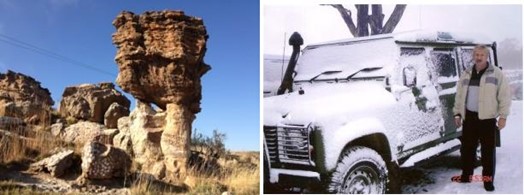
Convoy Rules
1. Keep a good following distance - not to close, but in sight. Keep dust gaps.
2. Keep Lights on
3. Wait for the vehicle in front of you to complete obstacles before you attempting it.
4. Look out for the vehicle behind you - Stop when you do not see it. Let the rest of the convoy know by radio that you have stopped.
5. Do not overtake, keep your posistion in the convoy.
6. Be considerate (Do not delay the convoy , but you have the right to take photos). Be considerate when others are using the bush toilet - give them same space.
7. Use proper radio procedures
8. Normally, a permit is needed to drive in a convoy
Radio Etiquette
1. Don’t use bad language
2. Do not use the following words unless it is an emergency :
“Mayday, mayday, mayday” , “need assistance”, “need medical assistance” , “emergency”.
3. Stay away from the transmit button, unless you intended to take part in conversations.
4. Keep transmissions short.
5. Speak clearly and slowly.
6. Identify yourself.
7. Call first and wait a few second before sending a message. This give time for others to get ready for listening.
8. Immediately release the button after your message
9. Wait a half second after depressing the transmit button, before calling.
Bush Etiquette
1. Tread lightly
2. Obey local rules and respect locals
3. Do not play music or make noise
4. Keep gates as found
5. Animals have right of way.
6. Build fires only in designated places.
7. Camp at designated places.
8. Do not collect wood for fire.
9. No fire must be left unattended, wind must be monitored.
Tread Lightly - visit the Tread Lightly website and join them.
It is all about minimizing your impact on the environment
1. Do not use chemicals, only bio-degradeble products
2. Stick to existing roads & tracks
3. Do not disturb or scare animals
4. Do not litter, bring out what you take in
5. Go out in small groups
6. Do not take samples and do not abuse
Bush Toilet
1. Respect each persons space and privacy - males left and females right.
2. Dig a cat-hole at least 60m from water sources. Choose a spot away from other holes used previously as toilets. Several small holes far apart from each other will allow for faster decomposition than one large big hole for all to use.
3. Choose an elevated site where water is unlikely to pool when it rains, to assure maximum decomposition before it reaches by someway their path to water sources. Avoid sandy washes where water is likely to flow, even in dry season.
4. Rich organic soil is generally better for decomposition than sandy soil. A sunny spot is good, because heat and sunlight aids in breaking down and disinfecting waste. Make shallow cat holes (10-15cm) in desert or semi-desert areas like the Richtersveld where the soil is low in organic content and decomposer micro-organisms. This will allow sun to penetrate.
5. To make a cat hole work effectively, you must break up the faeces with a stick and mix them with partly decayed leaves and twiggs.
6. Mark your spot to warn other cat-holers. It is strange how everyone tends to head for the same “discreet” spot.
7. Burning the paper puts you at risk to start a wildfire. Be careful.
8. Tampons and sanitary towels really should be packed in a plastic bag and taken out. They don't decompose (or burn) easily and animals may dig them up.
1. Keep a good following distance - not to close, but in sight. Keep dust gaps.
2. Keep Lights on
3. Wait for the vehicle in front of you to complete obstacles before you attempting it.
4. Look out for the vehicle behind you - Stop when you do not see it. Let the rest of the convoy know by radio that you have stopped.
5. Do not overtake, keep your posistion in the convoy.
6. Be considerate (Do not delay the convoy , but you have the right to take photos). Be considerate when others are using the bush toilet - give them same space.
7. Use proper radio procedures
8. Normally, a permit is needed to drive in a convoy
Radio Etiquette
1. Don’t use bad language
2. Do not use the following words unless it is an emergency :
“Mayday, mayday, mayday” , “need assistance”, “need medical assistance” , “emergency”.
3. Stay away from the transmit button, unless you intended to take part in conversations.
4. Keep transmissions short.
5. Speak clearly and slowly.
6. Identify yourself.
7. Call first and wait a few second before sending a message. This give time for others to get ready for listening.
8. Immediately release the button after your message
9. Wait a half second after depressing the transmit button, before calling.
Bush Etiquette
1. Tread lightly
2. Obey local rules and respect locals
3. Do not play music or make noise
4. Keep gates as found
5. Animals have right of way.
6. Build fires only in designated places.
7. Camp at designated places.
8. Do not collect wood for fire.
9. No fire must be left unattended, wind must be monitored.
Tread Lightly - visit the Tread Lightly website and join them.
It is all about minimizing your impact on the environment
1. Do not use chemicals, only bio-degradeble products
2. Stick to existing roads & tracks
3. Do not disturb or scare animals
4. Do not litter, bring out what you take in
5. Go out in small groups
6. Do not take samples and do not abuse
Bush Toilet
1. Respect each persons space and privacy - males left and females right.
2. Dig a cat-hole at least 60m from water sources. Choose a spot away from other holes used previously as toilets. Several small holes far apart from each other will allow for faster decomposition than one large big hole for all to use.
3. Choose an elevated site where water is unlikely to pool when it rains, to assure maximum decomposition before it reaches by someway their path to water sources. Avoid sandy washes where water is likely to flow, even in dry season.
4. Rich organic soil is generally better for decomposition than sandy soil. A sunny spot is good, because heat and sunlight aids in breaking down and disinfecting waste. Make shallow cat holes (10-15cm) in desert or semi-desert areas like the Richtersveld where the soil is low in organic content and decomposer micro-organisms. This will allow sun to penetrate.
5. To make a cat hole work effectively, you must break up the faeces with a stick and mix them with partly decayed leaves and twiggs.
6. Mark your spot to warn other cat-holers. It is strange how everyone tends to head for the same “discreet” spot.
7. Burning the paper puts you at risk to start a wildfire. Be careful.
8. Tampons and sanitary towels really should be packed in a plastic bag and taken out. They don't decompose (or burn) easily and animals may dig them up.

4x4 Offroad Academy

Professional 4x4 Training
Advanced 4x4 Recovery
Green Standards
Online Training
Advanced 4x4 Recovery
Green Standards
Online Training
Press "Ctrl+F5" to refresh the page All links are opened in a new window



